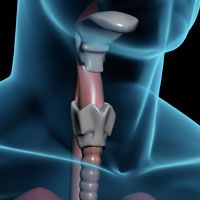Thyroid Toxicity May Predict Response to Immunotherapy in Metastatic NSCLC
The presence of hypothyroidism caused by treatment with immunotherapy correlated with improvement in overall survival among patients with non–small cell lung cancer, suggesting that thyroid toxicity may be a predictor of response to immunotherapy in this patient population.

The presence of hypothyroidism caused by treatment with immunotherapy correlated with improvement in overall survival (OS) among patients with non–small cell lung cancer (NSCLC), suggesting that thyroid toxicity may be a predictor of response to immunotherapy in this patient population.
Findings around thyroid toxicity and its impact on OS in patients with NSCLC treated with immunotherapy was presented in a poster during the European Society of Medical Oncology (ESMO) Virtual Congress.
The retrospective observational cohort study was brought on by the incidence of thyroid dysfunction in patients with lung cancer, in general, which is between 2% and 20%. Also, prior studies were indicative of the predictive value with thyroid toxicity in determining patients’ likeliness to have improved outcomes with immunotherapy. The goal of the study was to assess the relationship between thyroid toxicity and immunotherapy and how the relationship impacts progression-free survival (PFS), in addition to OS in patients with metastatic disease.
A total of 99 patients with metastatic NSCLC were followed from September of 2013 to March of 2019. The median age of patients in the study was 65 years, and the majority (61%) were male. Also, the majority of patients (87%) had adenocarcinoma. In terms of the type of immunotherapy used, most patients (42%) were treated with nivolumab (Opdivo). Thirty-nine percent of patients were treated with pembrolizumab (Keytruda), and 7% were treated with chemoimmunotherapy. There was also a small percentage of patients who received atezolizumab (Tecentriq), or the combination of nivolumab plus ipilimumab (Yervoy).
Investigators led by Vanesa Kazanietz of Hospital Italiano in Buenos Ares, Argentina, evaluated thyroid function in 83 of the patients enrolled. The result showed that 19 patients (23%) developed hypothyroidism. Another 13 patients (15.7%) developed hyperthyroidism, and of those patients, 8 (62%) later developed hypothyroidism.
Based on the log-rank evaluation, the OS observed in patients with hypothyroidism was 32.7 months compared with 16.2 months in patients who did not have hypothyroidism (log-rank P =.0088). The OS rate at 1 year was 100% in patients who developed hypothyroidism compared with only 50% in those without hypothyroidism.
The PFS among patients with hypothyroidism was 26 months compared with 9.9 months among those who did not have hypothyroidism (log-rank P =.0772).
Contrary to the presence of hypothyroidism in patients, hypothyroidism was not found to be associated with OS or PFS. Hypothyroidism was determined to be an independent prognostic factor for OS (P =.045), according to a multivariate analysis.
The overall response rate (ORR) among patients with hypothyroidism was 55% with a disease control rate (DCR) of 94%, and progressive disease (PD) in only 5% of the population. The ORR in the group of patients who did not have hypothyroidism was 39% with a DCR of 72% and PD in 28% of the group.
Overall, patients included to determine the predictive value of thyroid toxicity for response to immunotherapy were those with an altered thyroid-stimulating hormone before and during immunotherapy. Patient characteristics displayed on the poster showed that 57 patients who did not have hypothyroidism had terabecquerel compared with 16 patients who had hypothyroidism (P =.426). In terms of metastatic NSCLC stage in the non-hypothyroidism groups versus the hypothyroidism group, 5 versus 0 patients were stage I, 5 versus 1 were stage II, 3 versus 2 were stage IIIA, 8 versus 3 were stage IIIB, 2 versus 0 were stage IIIC, and 41 versus 13 were stage IV, respectively (P =.508).
In terms of performance status (PS), 23 of the patients in the non-hypothyroidism group had a score of 0 compared with 5 of those with hypothyroidism. A PS of 1 was observed in 37 patients without hypothyroidism versus 14 patients with hypothyroidism (P =.607).
The difference in PD-L1 status between the 2 groups was P = 1.000). Most of the patients enrolled had a PD-L1 status >50% including 16 patients in the non-hypothyroidism group and 5 in the hypothyroidism group. Ten patients without hypothyroidism had a PD-L1 >1% through 49% versus 2 of those with hypothyroidism. A significant percentage of patients were PD-L1-negative, including 10 patients who did not have hypothyroidism and 4 patients who did. PD-L1 status was not measured in 22 patients from the non-hypothyroidism group and 6 from the hypothyroidism group.
Finally, the difference in linea was P =.679. Linea was 1 for 17 patients in the non-hypothyroidism group versus 6 patients who had hypothyroidism. Linea was 2 for the majority of patients, including 42 patients without hypothyroidism versus 11 with hypothyroidism.
All patients in the study received immunotherapy at the Hospital Italiano de Buenos Ares. Notably, this is the first study to evaluated thyroid toxicity as a predictor of response to immunotherapy in patients with metastatic NSCLC in Latin America. It is part of a series around the issue, Kaznietz et al noted.
Reference:
Kazanietz V, Fernanda RM, Sergio S, et al. Thyroid toxicity as predictor of response to immunotherapy in lung cancer. Presentted at 2020 ESMO Congress; September 19-21, 2020; Virtual. Abstract 1917P